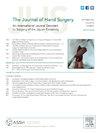Biomechanical Comparison of Suture Caliber and Number of Passes in Epitendinous Repair
IF 2.1
2区 医学
Q2 ORTHOPEDICS
引用次数: 0
Abstract
Purpose
The epitendinous suture is a critical part of flexor tendon repair. In addition to smoothing the repair site, it augments repair strength and increases gap resistance. This study aimed to determine whether increasing the number of passes or increasing suture caliber would improve the strength (primary outcome), 2 mm gap resistance, or stiffness of a simple running epitendinous suture.
Methods
A total of 30 flexor pollicis longus (FPL), flexor digitorum profundus (FDP), and flexor digitorum superficialis (FDS) tendons were harvested from three cadavers, and transverse tendon lacerations were produced. Tendons were repaired with only an epitendinous suture (no core suture) in three groups: 6-0 Prolene with six passes, 5-0 Prolene with six passes, or 5-0 Prolene with six passes. Epitendinous repair strength was tested using a materials testing machine.
Results
The use of eight passes had significantly greater ultimate tensile strength than six passes (21 +/− 7 N vs 14 +/− 5 N). Although 5-0 suture had a higher average ultimate tensile strength than 6-0 suture, this difference was not statistically significant (14 N +/− 5 vs 10 N +/− 3). Failure mode for all groups was most often suture tear-through.
Conclusions
A simple epitendinous suture using eight passes provides almost 50% more epitendinous repair strength and greater 2 mm gap resistance than six passes when using 5-0 Prolene.
Clinical relevance
When performing a simple running epitendinous repair to augment a core flexor tendon repair, the surgeon should consider the additional strength and gap resistance provided by eight passes compared to six.
外延性修复中缝线口径和缝线次数的生物力学比较。
目的:表腱缝合线是屈肌腱修复的关键部分。除了平滑修复部位外,它还能增强修复强度并提高间隙阻力。本研究旨在确定增加缝合次数或增大缝合线口径是否能提高简单跑动表腱缝合线的强度(主要结果)、2 毫米间隙阻力或硬度:方法:从三具尸体上共采集了 30 条膝屈肌(FPL)、趾屈肌(FDP)和趾浅屈肌(FDS)肌腱,并制作了横向肌腱裂口。只用表腱缝合线(无核心缝合线)修复肌腱,分为三组:6-0 Prolene 缝合六针、5-0 Prolene 缝合六针或 5-0 Prolene 缝合六针。使用材料试验机测试了表腱修复强度:结果:使用八道缝合线的极限拉伸强度明显高于六道缝合线(21 +/- 7 N vs 14 +/- 5 N)。虽然 5-0 缝线的平均极限拉伸强度高于 6-0 缝线,但这一差异在统计学上并不显著(14 N +/- 5 vs 10 N +/-3)。所有组别的失效模式最常见的是缝线撕裂:结论:与使用 5-0 Prolene 缝线的六次缝合相比,使用八次的简单外腱膜缝合可增加近 50% 的外腱膜修复强度和更大的 2 mm 间隙阻力:临床相关性:在进行简单的跑动式表腱缝合以增强核心屈肌腱修复时,外科医生应考虑八次缝合比六次缝合所提供的额外强度和间隙阻力。
本文章由计算机程序翻译,如有差异,请以英文原文为准。
求助全文
约1分钟内获得全文
求助全文
来源期刊
CiteScore
3.20
自引率
10.50%
发文量
402
审稿时长
12 weeks
期刊介绍:
The Journal of Hand Surgery publishes original, peer-reviewed articles related to the pathophysiology, diagnosis, and treatment of diseases and conditions of the upper extremity; these include both clinical and basic science studies, along with case reports. Special features include Review Articles (including Current Concepts and The Hand Surgery Landscape), Reviews of Books and Media, and Letters to the Editor.

 求助内容:
求助内容: 应助结果提醒方式:
应助结果提醒方式:


